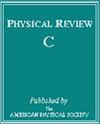Decay of a microsecond seniority 3 isomeric state in Hf155
IF 3.4
2区 物理与天体物理
Q1 Physics and Astronomy
引用次数: 0
Abstract
Excited states in the neutron-deficient nuclide have been investigated in experiments performed at the Accelerator Laboratory of the University of Jyväskylä. The nuclei were produced in fusion-evaporation reactions induced by beams of 295 and 315 MeV ions bombarding an isotopically enriched target and separated using the recoil mass separator MARA. An isomeric state having a half-life of 510(30) ns was discovered and is interpreted as a seniority configuration. The -ray transitions emitted in the deexcitation of the isomeric state to the ground state were identified and a level scheme was constructed, from which the excitation energy of the isomer was determined to be 2581.5(10) keV. A value of 0.45(3) W.u. was deduced for the 105.4 keV transition depopulating the isomeric state. The deduced level scheme and value are compared with systematics and shell-model calculations.

Hf155 中微秒级 3 异构态的衰变
于韦斯屈莱大学加速器实验室在实验中研究了缺中子核素Hf155的激发态。Hf155 核是在 295 和 315 MeV Ni58 离子束轰击同位素富集的 Pd102 靶件所诱发的聚变-蒸发反应中产生的,并使用反冲质量分离器 MARA 进行分离。发现了一种半衰期为 510(30) ns 的异构态,并将其解释为资历υ=3,(πh11/22⊗νf7/2)27/2-构型。确定了异构态脱激发至基态过程中发射的 γ 射线跃迁,并构建了一个能级方案,由此确定异构态的激发能量为 2581.5(10) keV。推导出异构态的 105.4 keV 转变的 B(E2) 值为 0.45(3) W.u.。推导出的水平方案和 B(E2)值与系统学和壳模型计算结果进行了比较。
本文章由计算机程序翻译,如有差异,请以英文原文为准。
求助全文
约1分钟内获得全文
求助全文
来源期刊

Physical Review C
物理-物理:核物理
CiteScore
5.70
自引率
35.50%
发文量
0
审稿时长
1-2 weeks
期刊介绍:
Physical Review C (PRC) is a leading journal in theoretical and experimental nuclear physics, publishing more than two-thirds of the research literature in the field.
PRC covers experimental and theoretical results in all aspects of nuclear physics, including:
Nucleon-nucleon interaction, few-body systems
Nuclear structure
Nuclear reactions
Relativistic nuclear collisions
Hadronic physics and QCD
Electroweak interaction, symmetries
Nuclear astrophysics
 求助内容:
求助内容: 应助结果提醒方式:
应助结果提醒方式:


